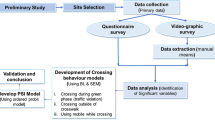Abstract
The compliance behavior of pedestrians at controlled intersections is an important determinant of the number of crashes involving pedestrians at those intersections. The objective of this study was to explore compliance behavior of the pedestrians at vehicular traffic signals and traffic-police-controlled intersections in Dhaka, Bangladesh. Two types of compliance behavior were examined: compliance with vehicular traffic signals and traffic police direction, and compliance with crosswalk. First, factors influencing each compliance behavior of pedestrians were identified from the existing literature and correlation test results. With those identified factors, two discrete choice models were developed: a multinomial logistic (MNL) model for explaining the compliance behavior with vehicular traffic signals and traffic police direction, and a binary (BLR) model for exploring the compliance behavior with crosswalk. The results of the MNL model showed that compliance behavior was significantly associated with intersection control type, gender, crossing group, baggage handling by pedestrian, and vehicle flow. Whereas, the BLR model showed that compliance with crosswalk was significantly influenced by age of the pedestrians, compliance with intersection control direction by pedestrians, and vehicle flow. These findings would help the policy-makers to take countermeasures to alleviate traffic safety related problems.




Similar content being viewed by others
Explore related subjects
Discover the latest articles, news and stories from top researchers in related subjects.References
World Health Organization: Global Status Report on Road Safety 2013: Supporting a Decade of Action: Summary. World Health Organization. http://www.who.int/iris/handle/10665/83789 (2013)
ARI: Road Safety Facts 2013. http://ari.buet.ac.bd/downloads/Facts.2013.pdf (2015). Accessed 12 Oct 2018
National Highway Traffic Safety Administration (NHTSA): Fatality Analysis Reporting System Web-Based Encyclopedia. http://wwwfars.nhtsa.dot.gov/ (2000). Accessed 21 Jan 2019
Marisamynathan, S., Vedagiri, P.: Modeling pedestrian crossing behavior and safety at signalized intersections. Transp. Res. Rec. 2672(31), 76–86 (2018). https://doi.org/10.1177/2F0361198118759075
Onelcin, P., Alver, Y.: The crossing speed and safety margin of pedestrians at signalized intersections. Transp. Res. Procedia. 22, 3–12 (2017). https://doi.org/10.1016/j.trpro.2017.03.002
Hamidun, R., Kordi, N.E., Endut, I.R., Ishak, S.Z.: Behavioral observations of crossing pedestrians at urban signalized intersections. Jurnal Teknologi. 78(5–2), 9 (2016)
Koh, P.P., Wong, Y.D., Chandrasekar, P.: Safety evaluation of pedestrian behaviour and violations at signalised pedestrian crossings. Saf. Sci. 70, 143–152 (2014). https://doi.org/10.1016/j.ssci.2014.05.010
Li, Y., Fernie, G.: Pedestrian behavior and safety on a two-stage crossing with a center refuge island and the effect of winter weather on pedestrian compliance rate. Accid. Anal. Prev. 42(4), 1156–1163 (2010). https://doi.org/10.1016/j.aap.2010.01.004
Zeedyk, M.S., Kelly, L.: Behavioural observations of adult–child pairs at pedestrian crossings. Accid. Anal. Prev. 35(5), 771–776 (2003). https://doi.org/10.1016/S0001-4575(02)00086-6
Zhang, G., Yau, K.K., Chen, G.: Risk factors associated with traffic violations and accident severity in China. Accid. Anal. Prev. 59, 18–25 (2013). https://doi.org/10.1016/j.aap.2013.05.004
Rosenbloom, T.: Crossing at a red light: behaviour of individuals and groups. Transport. Res. F: Traffic Psychol. Behav. 12(5), 389–394 (2009). https://doi.org/10.1016/j.trf.2009.05.002
Holland, C., Hill, R.: Gender differences in factors predicting unsafe crossing decisions in adult pedestrians across the lifespan: a simulation study. Accid. Anal. Prev. 42(4), 1097–1106 (2010). https://doi.org/10.1016/j.aap.2009.12.023
Marisamynathan, P.V.: Study on pedestrian crossing behavior at signalized intersections. J. Traffic Transp. Eng. (English edition). 1(2), 103–110 (2014). https://doi.org/10.1016/S2095-7564(15)30094-5
Zhuang, X., Wu, C.: Pedestrians’ crossing behaviors and safety at unmarked roadway in China. Accid. Anal. Prev. 43(6), 1927–1936 (2011). https://doi.org/10.1016/j.aap.2011.05.005
Li, B.: A model of pedestrians’ intended waiting times for street crossings at signalized intersections. Transp. Res. B Methodol. 51, 17–28 (2013). https://doi.org/10.1016/j.trb.2013.02.002
Guo, H., Gao, Z., Yang, X., Jiang, X.: Modeling pedestrian violation behavior at signalized crosswalks in China: a hazards-based duration approach. Traffic Inj. Prev. 12(1), 96–103 (2011). https://doi.org/10.1080/15389588.2010.518652
Brosseau, M., Zangenehpour, S., Saunier, N., Miranda-Moreno, L.: The impact of waiting time and other factors on dangerous pedestrian crossings and violations at signalized intersections: a case study in Montreal. Transport. Res. F: Traffic Psychol. Behav. 21, 159–172 (2013). https://doi.org/10.1016/j.trf.2013.09.010
Van Houten, R., Ellis, R., Kim, J.L.: The effects of varying minimum green on the percentage of pedestrians waiting to cross with the WALK signal at midblock crosswalks. Transp. Res. Rec. 2002–10, 78–83 (2007). https://doi.org/10.3141/2F2002-10
Zafri, N.M., Rony, A.I., Adri, N.: Analysis of pedestrian crossing speed and waiting time at intersections in Dhaka. Infrastructures. 4(3), 39 (2019). https://doi.org/10.3390/infrastructures4030039
Rahman, M.M., Khadem, R.: Deficiencies of traffic signal system in Dhaka City. J. Soc. Transp Traffic Stud. 3, 63–73 (2012)
Hamidun, R., Kordi, N.E., Endut, I.R., Ishak, S.Z., Yusoff, M.F.M.: Estimation of illegal crossing accident risk using stochastic petri nets. India J. Eng. Sci. Technol. 10(Special Issue on Advances in Civil and Environmental Engineering), 81–93 (2015)
Granié, M.A.: Effects of gender, sex-stereotype conformity, age and internalization on risk-taking among adolescent pedestrians. Saf. Sci. 47(9), 1277–1283 (2009). https://doi.org/10.1016/j.ssci.2009.03.010
Wang, W., Guo, H., Gao, Z., Bubb, H.: Individual differences of pedestrian behaviour in midblock crosswalk and intersection. Int. J. Crashworthiness. 16(1), 1–9 (2011). https://doi.org/10.1080/13588265.2010.491715
Cohen, P., West, S.G., Aiken, L.S.: Applied Multiple Regression/Correlation Analysis for the Behavioral Sciences. Psychology Press, New York (2014). https://doi.org/10.4324/9781410606266
Abdulhafedh, A.: Incorporating the multinomial logistic regression in vehicle crash severity modeling: a detailed overview. J. Transpor. Technol. 7(03), 279 (2017). https://doi.org/10.4236/jtts.2017.73019
Liao, T.F.: Interpreting Probability Models: Logit, Probit, and Other Generalized Linear Models, vol. 101. Sage, Thousand Oaks (1994)
Long, S.J., Freese, J.: Regression models for categorical dependent variables using stata. Texas: A Stata Press Publication (2006).
Levasseur, M., McTiernan, D., Brisbane, G.: Pedestrian countdown timers: two Australian trial methods and results. In ARRB Conference, 25th, 2012, Perth, Western Australia, Australia. (2012)
Jain, A., Gupta, A., Rastogi, R.: Pedestrian crossing behaviour analysis at intersections. International Journal for Traffic and Transport Engineering. 4(1), 103–116 (2014). https://doi.org/10.7708/ijtte.2014.4(1).08
KVR, R., Nair, P.M.: Pedestrian risk analysis at uncontrolled midblock and unsignalised intersections. J Traffic Transp Eng (English Edition). 5(2), 137–147 (2018). https://doi.org/10.1016/j.jtte.2017.06.005
Author information
Authors and Affiliations
Corresponding author
Additional information
Publisher’s Note
Springer Nature remains neutral with regard to jurisdictional claims in published maps and institutional affiliations.
Rights and permissions
About this article
Cite this article
Zafri, N.M., Rony, A.I. & Adri, N. Study on Pedestrian Compliance Behavior at Vehicular Traffic Signals and Traffic-Police-Controlled Intersections. Int. J. ITS Res. 18, 400–411 (2020). https://doi.org/10.1007/s13177-019-00208-y
Received:
Revised:
Accepted:
Published:
Issue Date:
DOI: https://doi.org/10.1007/s13177-019-00208-y




